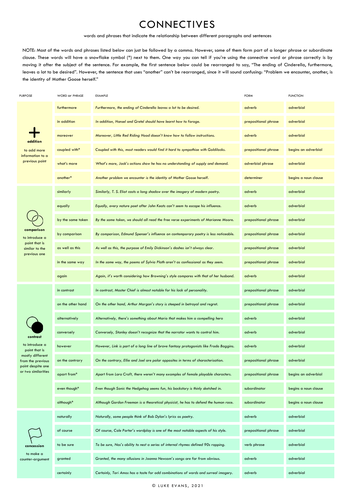

A collection of words and phrases that will help students to achieve greater coherence when writing paragraphs. Each connective comes with an example of how to use it, along with grammatical information on its form (i.e. word class/ part of speech) and function (i.e. whether it’s an adverbial or if it begins a clause). There is also additional guidance on the difference between ‘movable’ connectives (adverbials such as furthermore) and ‘immovable’ connectives (such as although). The connectives are divided into the following categories:
- addition: to add information to a previous point
- comparison: to introduce a point that is similar to the previous one
- contrast: to introduce a point that is mostly different from the previous point despite one or two similarities
- concession: to make a counter-argument
- refutation: to continue with your main argument after making a counter-argument
- restatement: to make an argument clearer by phrasing it in a different way
- exemplification: to make an argument clearer by providing an example
- summary: to simplify information down to the main details
- frequency: to show how often something happens
- causality: to imply cause and effect between two pieces of information
- sequence: to structure information in a sequence
Something went wrong, please try again later.
This resource hasn't been reviewed yet
To ensure quality for our reviews, only customers who have purchased this resource can review it
Report this resourceto let us know if it violates our terms and conditions.
Our customer service team will review your report and will be in touch.